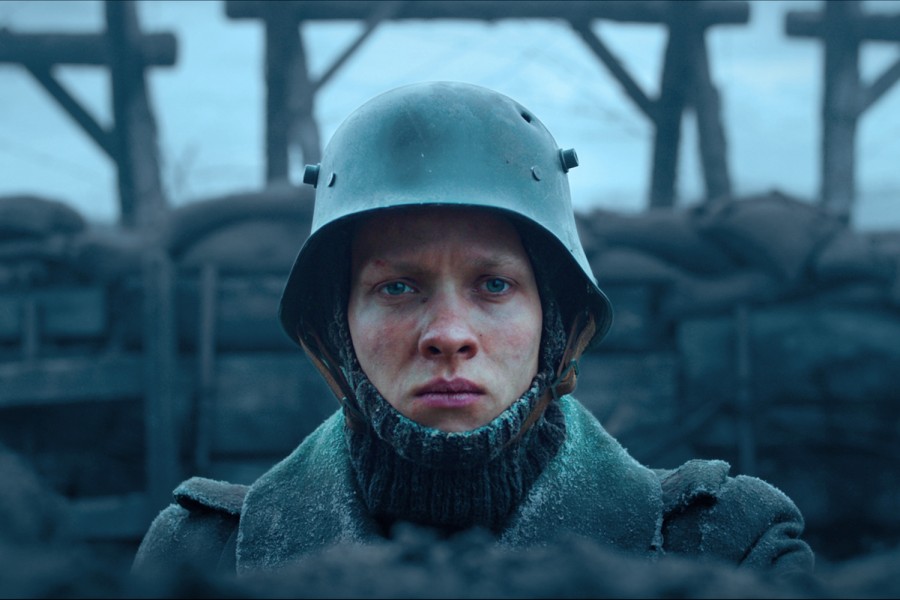Review: Carnage and cannon fire in ‘All Quiet on the Western Front’
Nominated for nine Academy Awards, Edward Berger’s adaptation of “All Quiet on the Western Front” laments the lives lost to the folly of war. “All Quiet on the Western Front” is available for streaming on Netflix and is showing in select theaters.
March 8, 2023
Award season favorite “All Quiet on the Western Front” (2022) masterfully builds immersive visual scale and emotional depth, delivering an unfiltered elegy to the Lost Generation. The third adaptation of Erich Maria Remarque’s classic novel by the same name, Edward Berger’s Netflix-backed revival of this visceral anti-war treatise has earned nine Oscar nominations, including the coveted best picture award. The film follows German soldier Paul Bäumer (Felix Kammerer), as he and a company of young foot soldiers charge head first onto the frontlines of World War I.
Expecting a glorious adventure, the young men are instead met with ceaseless enemy bombardment and brutal close-quarters combat. In the muddy trenches of northern France, Berger presents the mass dehumanization, disillusionment and decimation of youth in times of war. This rendition of “All Quiet on the Western Front” is not only significant because of its parallel in the contemporary Russian invasion of Ukraine, but also because it is the first time the story has been told by a German cast and crew. In its 148-minute runtime, the film confronts the audience with the unforgiving brutality of warfare, and follows the young men who shoulder the damaging costs of geopolitical ambitions.
On a purely aesthetic level, the film’s visual style perfectly captures an atmosphere of dread. A dreary palette of dark gray uniforms and bloodstained mud sets the tone for the hellish environment of trench warfare. Tanks resembling mythical beasts crawl out of a curtain of gunsmoke, plowing through barricades and bodies alike. As machine gun fire and artillery rounds rip through legions of men and debris, faint clouds of crimson blood linger in the air. This attention to detail on all scales effectively pushes viewers into the pandemonium of armed conflict, where war is not a patriotic dream, but rather a waking nightmare.
While impressive special effects techniques are employed to construct the reality of the battlefield, it is the central performance from rookie actor Felix Kammerer that truly engrosses the audience in the film’s heartbreaking journey of suffering. From an idealistic volunteer to a traumatized shell of a person, Kammerer intensely conveys the detrimental physical and psychological tolls of war. In various close up shots of Bäumer, the camera reveals eyes that are dull and lifeless; his penetrating gaze projects a lifetime of trauma.
The tragedy of Bäumer is further elevated by cutting to scenes of backdoor political negotiation. Led by Matthias Erzberger (Daniel Brühl), the German delegation crosses enemy borders to broker a ceasefire with the French military, which will only accept on the condition that the Germans sign a humiliating armistice. To the proud generals, dressed in well-ironed and medal-adorned uniforms, men like Bäumer are disposable pawns on a far-off chessboard. The juxtaposition of these two parallel struggles, one on a vast, scarred landscape and the other in the tense confines of a train car, creates a dire sense of urgency. Despite its relatively long runtime, the film keeps the viewer constantly invested in the events playing out on screen.
“All Quiet on the Western Front” also masterfully conveys its somber themes through Volker Bertelmann’s arresting score. Largely composed on Bertelmann’s great-grandmother’s antique harmonium instrument, his compositions sonically ground the film in the early 20th century. Each note reverberates ominously through the bleak shots of craters filled with murky rainwater and human remains. The score often brings out Bäumer’s inner emotions, broadcasting a persistent fear of imminent danger and an all-consuming feeling of despair. In moments where characters can’t find the words to illustrate frustration and grief, the music speaks for them.
Having already received numerous accolades from critics and in award ceremonies internationally, including dominating the 76th British Academy Film Awards with a record-breaking seven wins, “All Quiet on the Western Front” has undeniably left an indelible mark on audiences around the world. While it’s easy to point to the ongoing Russian invasion of Ukraine as a reason for the film’s resonance, especially with European audiences, that dismisses the film’s intrinsic universality. Few people are strangers to the terrors of war. Whether it is through hearing accounts from family members, watching the news or actually experiencing armed crises, the fear of war hangs over many people’s heads.
“All Quiet on the Western Front” reminds audiences of the incalculable human costs incurred when imperialistic ambitions grip a nation. As Remarque put it, moving pieces of anti-war art like this are “neither an accusation nor a confession, and least of all an adventure, for death is not an adventure to those who stand face to face with it.”
Contact Mick Gaw at [email protected].

























































































































































